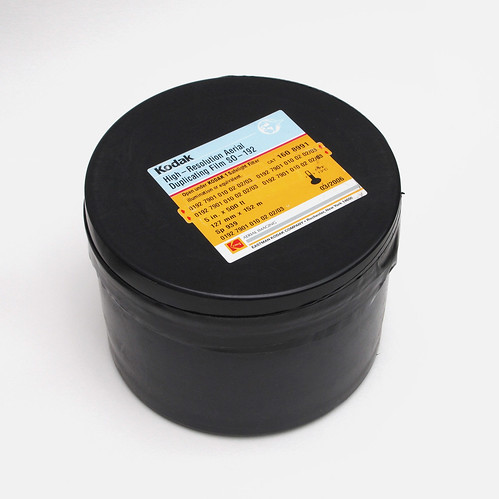 |
| Kodak High Resolution Aerial Duplicating Film SO-192 |
Sometimes when searching for photographic materials online, one finds quite obscure films on auction sites. This drum of Kodak High-Resolution Aerial Duplicating film was a entirely speculative bid, not really knowing exactly what it was; I calculated, that, being 5 inches wide, the 500ft of film could be cut to
1,500 sheets of 4x5. That's a lot of photographic material. It has a date of 03/2006, but given the nature of the emulsion type, unless stored in the worst conditions, this age would have little bearing on the film.
 |
| Kodak High-Resolution Duplicating Film label |
Research online brought up
a data sheet which provided more information about the film. The name itself is entirely descriptive, but the data sheet elaborates:
The blue-sensitive, hardened emulsions of this film is extremely fine
grain and of extremely high resolving power. The film is designed for
duplicating very fine grain, high-definition aerial negatives. It is
intended for use as a second-generation positive and a third-generation
negative.
Kodak still make
a number of films for aerial imaging. This film is available to buy from selective suppliers, which may mean that Kodak are still producing it, although, like other recently discontinued films, it may be that there are sufficient stocks to meet demand for some time to come. The SO-192 code stands for 'special order': a number of Kodak films have special order numbers which denotes not only the type of emulsion, but also substrate, and other aspects such as format, perforations and so on. High Resolution Aerial Duplicating film is available on two thicknesses of film base, and each has its own SO number, SO-192 on 3.9 mils (0.10 mm), and SO-187 on 7.0 mils (0.178 mm) Estar base. As the film is blue-sensitive, it can be handled under normal darkroom safelights, Kodak recommending Safelight No.1, a red safelight, although as blue-sensitive, presumably yellow or amber would also be safe. Although not intended as a camera film, I wanted to use it as such. Information about exposure and development from Kodak is purely for its use as a duplicating film, but having used similar films before, I had some idea of the parameters of both. To make some initial tests, I cut a couple of lengths of the film (inside the large tub, the film is on a metal spool) with a rotary trimmer to the width of medium format, 62mm, and rolled these with 120 backing paper. Notably, the film itself is bright yellow. I used the first test to get a usable exposure index. I had read online that the film has a sensitivity around 2 ISO, and so shot the first tests with this in mind, bracketing exposure. The film was stand developed in R09 One Shot at 1+150 for one hour. The contact sheet below shows the results. The frames run right to left, and are rated (first row) 1, 2, 3, 4, (second row) 8, 16, then 3, 6, (third row) 6, 12, 24, 24, (fourth row) 50, 50, with the last two frames at 6 and 3 EI.
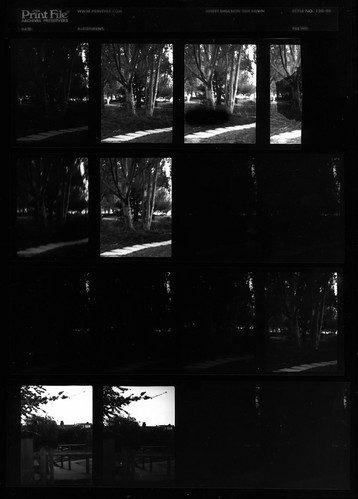 |
| Kodak High Resolution Aerial Duplicating Film contact sheet |
I did have problems with shooting this test roll: the shots needed long exposures, some of several seconds, and as
the Baldalux camera I used does not sit very securely on a tripod, there was camera shake blurring these shots, such as the image below. When developed, the film exhibited very high contrast, grain too fine to show when scanned from the negatives, very clear film base, and, as the contact sheet above demonstrates, no real latitude to the exposure. At 2 ISO, Kodak High Resolution Aerial Duplicating Film is slower than normal paper
emulsions, and slower than almost all of the old glass plates I have been using recently.
 |
| Kodak High Resolution Aerial Duplicating Film (6x4.5cm), Zodel Baldalux |
For a second test, I cut a couple of pieces to 4x5 inches, and shot them with the
MPP Micro-Technical Mk VI camera. In this test I wanted to see if pre-exposure would reduce apparent contrast by raising the shadow values, and exposed a strip across both of the two sheets in the darkroom when loading the film holders. This is most evident in the upper of the two images below, although in the second shot this pre-exposed strip is across the top of the shot amongst the branches making it harder to judge. Both sheets were stand developed in R09 One Shot, diluted 1+120 for one hour. The two photographs below show how important accurate exposure is with Kodak High Resolution Duplicating film as it has very little latitude: the shutter on the Xenar lens is sluggish at the slow speeds, leading to over-exposure, whereas perhaps the Tessar's shutter speeds were running a bit fast.
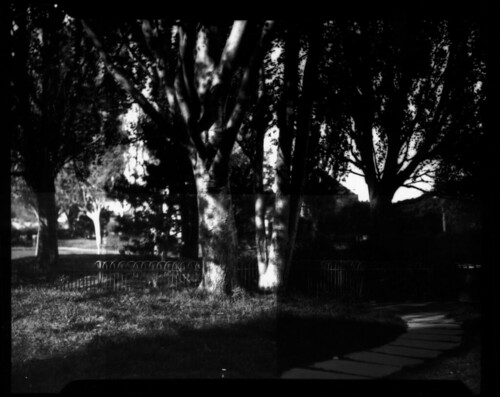 |
Kodak High Resolution Aerial Duplicating Film 5x4 inch test shot, 16.5cm Tessar, rated 5EI,
three successive exposures by progressively withdrawing the darkslide,
giving effective exposure indexes of 5, 2.5, 1.25 (left to right) |
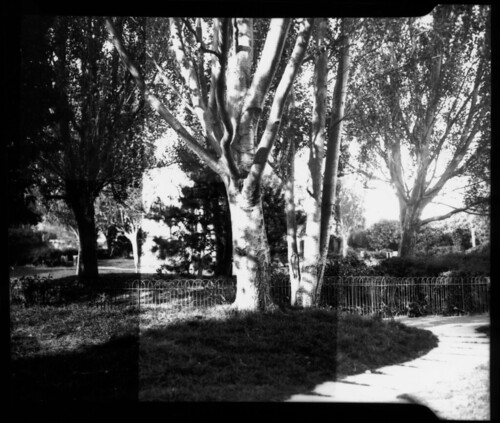 |
Kodak High Resolution Aerial Duplicating Film 5x4 inch test shot, 150mm Xenar, rated 6EI,
three successive exposures by progressively withdrawing the darkslide,
giving effective exposure indexes of 6, 3, 1.5 (left to right) |
I shot some more of the film in large format, although in bright sunny conditions, which meant that the inherent contrast was a problem. There is very little detail in either highlight or shadow areas. The image below was scanned from a contact print, scanning from the negative may possibly provide a little more detail at either end of the contrast range.
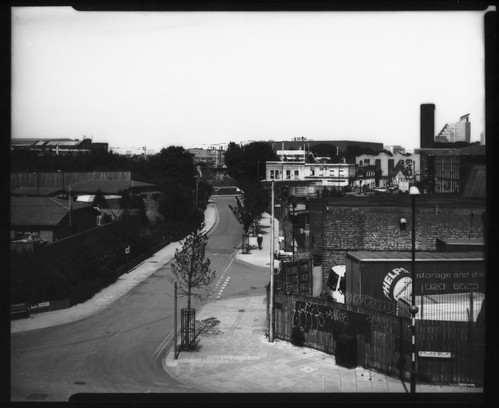 |
| Kodak High Resolution Aerial Duplicating Film 5x4 with 16.5cm Tessar |
Under overcast conditions, I shot another roll cut to medium format. Here I exclusively used long exposures of several seconds, perhaps more accurate than slow shutter speeds such as 1/2 or 1/5th, although I did not adjust for reciprocity law failure (on the data sheet it suggests adjusting an exposure of 1 second to 2 seconds). For this film I increased developer dilution, using stand development with R09 One Shot at 1+200 for one hour. The combination of flat lighting, accurate (but not adjusted) long exposures, and highly dilute film developer provided the best results. Although Kodak High Resolution Aerial Duplicating film has very specific applications, and is not intended as camera negative material, with the right treatment this is possible. No doubt the film would also be useful for creating negatives and positives by enlargement for alternative and contact processes.
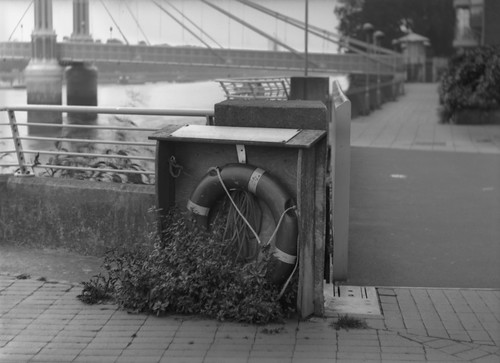 |
| Kodak High Resolution Aerial Duplicating Film (6x4.5cm), Wallace Heaton Zodel |
 |
| Kodak High Resolution Aerial Duplicating Film (6x4.5cm), Wallace Heaton Zodel |
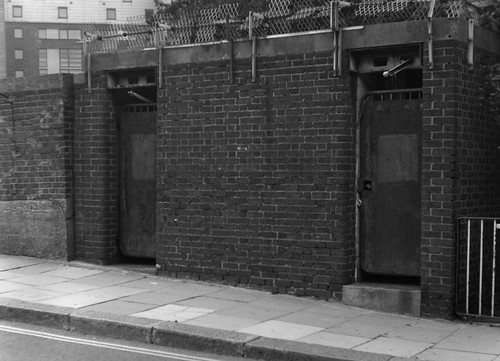 |
| Kodak High Resolution Aerial Duplicating Film (6x4.5cm), Wallace Heaton Zodel |
 |
| Kodak High Resolution Aerial Duplicating Film (6x4.5cm), Wallace Heaton Zodel |
Sources/further reading:
http://www.kodak.co.uk/ek/GB/en/High_Resolution_Aerial_Duplicating_Film_SO-192.htm
Kodak Aerial Films
Tom Philo's Kodak Film Number Cross Reference Table











I bought a similar roll of Agfa Avitone Orthochromatic film that is 4 inches wide, and have experimented cutting it to 5x4 and smaller for an Ensign Cameo 6x9 plate camera. This film is also yellow and has amazingly fine grain. It is a quite thin base, but very dimensionally stable. I think these films were designed for air reconnaissance. I know these films are 'safe' to open in red light darkroom conditions, but I can't quite risk taking out the whole roll in red light, so I cut off a length, and only expose that to red light - just in case...
ReplyDeleteDid the Agfa film come on a metal spool? I reckoned that even if the safelight isn't entirely safe for the film, it would not penetrate more than a couple of layers on the roll. The Kodak one is pretty heavy and not actually that easy to handle. I'm guessing that as a duplicating film, it's the same size as their other aerial films to be used essentially in contact with aerial negatives to reproduce them. Ideally, I should try printing some in the darkroom for optimal results; I would also quite like to attempt shooting the film in a 35mm camera.
DeleteJust owning up to stating the obvious with my comment about 'air reconnaissance'. The hint is in the name 'aerial' with Kodak, and 'Avi...' with Agfa. Duh!
ReplyDeleteI use duplicating film quite a bit for portraits since I love its orthochromatic nature. Just some tips I have learned: this film is meant to be developed in paper developer, not in film developer. You can do this under red light in a tray. Contrast is controlled by developer dilution so it actually has quite a bit of latitude. Now to contradict myself: although it was designed to be used with print developer, I get lovely results with this if I shoot it at ISO 1 or 2 and develop it in D-76 1:1 for 5-8 minutes under red light. That being said, the contrast control exerted by this method can result in some grain, though very little. I have used Ansco 130 and developed it for 1-2 minutes which has resulted in some really stunning images but also pinholes in the emulsion--super rapid development causes gas bubbles to develop which disperse the silver and you get a blank spot.
ReplyDeleteThanks for your comment - I haven't tried this in paper developer, but I have in the past used tray developing for large format, and not with very good results (I probably did not persevere long enough to get the hang of it, and so I've been using stand development instead).
DeleteTray developing generally has two main problems, related to each other, but it is worth sorting out since it allows you to see progress which is one of the main advantages of this film. Use a tray that's larger than the film so it can move around. 4x5 in 5x7, 5x7 in 8x10 etc. Bigger is better. The other problem, related to having too small a tray, is over-agitation creating density at the edges of the negative, or uneven development because the film can't move. You can do a semi-stand tray development thus: Put in film, emulsion side up, making sure the surface is quickly covered with liquid, and agitate for a full minute by lifting each corner no more than 1/2" and dropping. Do this in random order--don't create your own tidal system in there--gentle movement is enough. Then lift each corner once at the 1 minute mark, and every minute thereafter. Again, just a tiny bit. This takes 5-10 seconds. The good news is that this type of film, in my experience, seldom has the same issues as conventional film. I have seen uneven development just a couple of times when I tried using Pyrocat HD, never with any other developer and I have used at least 10 types on 200+ sheets of film. There are other issues instead--like the film's resistance to photo-flo or similar products (I always have to clean water spots off the base side), contrast challenges, pinholes, etc.
Delete